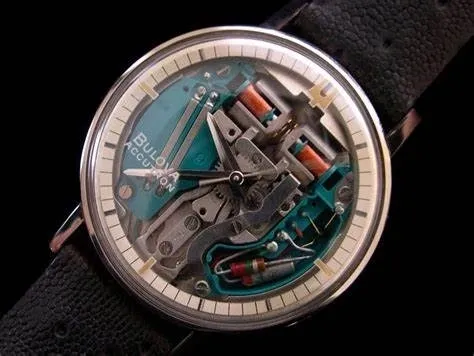
Why are people crazy for the Accutron?
As the ground-breaking timepiece continues to explore new technologies, it has fueled an ever-growing fan base.
BY RHONDA RICHE, Editor-At-Large
It’s no secret that Accutron watches attract a particularly rabid type of enthusiast. Early on in my collecting career, when the internet was just forums and people used flatbed scanners to share images of their timepieces, my most scanned watch was a Bulova Accutron “R.R. 218” Canadian Railroad watch.
The nec plus ultra of the Accutron is the Spaceview. Fan demand for this iconic timepiece fueled the recent relaunch of the Accutron as a separate entity from Bulova. We know people love it. The question is: why.?
The short answer is that there is no other watch quite like it.
The Accutron debuted in 1960, and it was a horological revolution. It was the world’s first fully electronic watch and used a tuning fork to regulate timekeeping, providing accuracy and precision that outperformed even the most expensive chronometer-certified wristwatches.
The early 1960s were an age of optimism. Space exploration stoked the public’s interest in science and technology, and the promise of tuning fork movements was a game-changer. The design cues of the Accutron were also daring. Asymmetric cases, for example, signaled a new age in aesthetics. But the boldest of these futuristic timepieces was the Spaceview.
The defining characteristic of the Spaceview is its lack of a dial. The design was initially conceived as a sales display model that dealers could use to demonstrate how the tuning fork-equipped watch worked. The striking look of the unique movement marked the first time buyers shaped the history of the Spaceview because interested parties wanted to buy the display model, and Accutron obliged.
The Spaceview proved to be more than a gimmick. Accutron’s engineers recognized that because the dial movement had so many colors, its hands needed to be broad and heavily lumed for optimum legibility. The earliest Spaceview watches printed the Bulova logo and the indices on the underside of the crystal (later versions added a chapter ring). The crown was tucked away on the caseback. And they came in a range of silhouettes – from formal to funky – to ensure that there was a Spaceview for everyone.
That leads us to another reason why the Spaceview is so alluring: Nostalgia. The original Spaceview came out at a time when everybody wore a watch, but this particular timepiece had been worn by test pilots, the most important influencers of the day. In a 2002 article about Spaceview collectors in the New York Times, one enthusiast was quoted: “It’s a connection somehow with our youth.”
Eventually, the tuning fork technology was rendered obsolete by even more accurate quartz-powered movements, and the original, Bulova-era run of the Accutron lasted only 17 years until 1977. While Bulova set aside enough parts for an estimated 15 years of repairs, it was difficult to get the watch serviced, which led to many models being set aside in a drawer. And because early Accutrons used solid gold or gold-filled cases, many of these discarded timepieces were scrapped when gold prices hit record highs in 1980 and 2008.
Still, there was a generation of collectors with a growing need to acquire it because the Spaceview evoked strong associations with the ingenuity of the Space Age and the optimism of the 1960s. Then the burgeoning reach of the internet enabled collectors to band together to celebrate their favorite designs and pool their resources to find increasingly rare models.
And over the decades, Bulova kept an eye on this growing cult of collectors.
In 2010, Bulova unveiled a limited edition, hand-made version of the Spaceview featuring the original electronic 360hz Accutron movement. (a $4000 steel watch) It was a hit. Meanwhile, the market for vintage pieces continued to grow. But the scarcity of parts led to a new kind of demand from collectors who wanted the aesthetic of the Spaceview without the fear of being unable to find someone to repair it.
Last year, Accutron officially spun off from Bulova, and the star attraction of the new collection was the Spaceview 2020. And in keeping with the tradition of technological innovation, this watch features a proprietary movement powered by electrostatic energy created by twin turbines that rotate, at incredible speeds, due to human motion between two electrodes affixed to the movement. This energy, stored in an accumulator, drives two motors: the world’s first electrostatic motor, which fuels the fluid second hand, and a step motor that powers the hour and minute hands. Both motors are synchronized through integrated circuits to provide accuracy to +/- 5 seconds a month.
While the Spaceview 2020 echoes the aesthetic of the avant-garde original, it’s definitely not your dad’s watch. The exposed movement, for example, uses the original’s signature green accents. But the layout has been tweaked to showcase the 2020’s unique caliber – the turbine-like blades of the rotor move quite rapidly, which offers an incredible visual experience.
This next generation of Accutron Spaceview honors the spirit of the original by not anchored to the past. In this way, it is informed by the desires of vintage fans but also piques the curiosity of the next wave of collectors. “These new timepieces, powered by electrostatic energy, are the first of their kind and pay tribute to the iconic Spaceview design that gave Accutron the recognition of being an industry trailblazer,” said Jeffrey Cohen, President of Citizen Watch America, when the Spaceview 2020 was launched. “Accutron will continue to maintain its position at the forefront of timekeeping accuracy and is committed to upholding an extraordinary legacy of excellence in design, style, and technology.”
The Spaceview 2020 comes with a stainless steel case and bezel on a black leather strap and is priced at $3,450. For more information, visit Accutron’s website.
Tags: